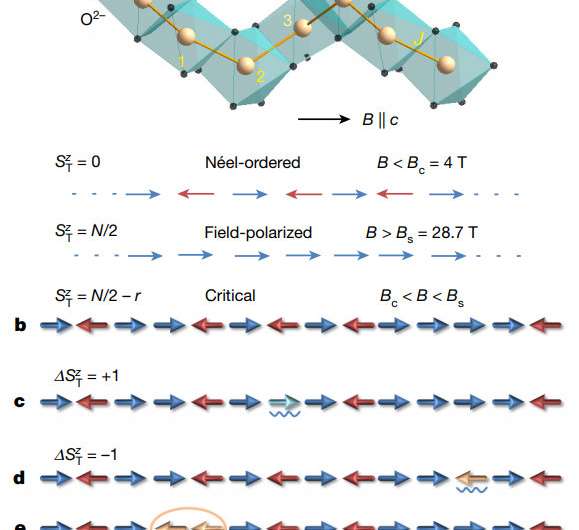Quantum spin chain in SrCo2V2O8, psinon–(anti)psinon pairs and strings. Credit: Nature (2018). DOI: 10.1038/nature25466
An international team of researchers has experimentally observed Bethe strings for the first time. In their paper published in the journal Nature, the team describes their experiments and what they observed, and offer possible implications of their work.
Bethe strings were first proposed over a century ago by German physicist Hans Bethe, who based them on theories by Werner Heisenberg, and are defined as a type of collective behavior in electrons—a behavior that can travel between particles. The research team with this new effort refers to them as "complex bound states of magnetic excitations." Some have described them as being similar to a line of people at a soccer game performing the "wave"—in this analogy, their up-and-down arm movements represent the up or down spin states of electrons. Bethe suggested their existence back in the 1930s, and others have refined the theory, but only recently has highly sophisticated technology emerged to test their existence.
As a means of observing them experimentally, the researchers first synthesized SrCo2V2O8 crystals—an antiferromagnetic Heisenberg-Ising chain. They then used high-resolution terahertz spectroscopy to resolve the spin states. Doing so allowed for calculating the string suggestions using the Bethe approach, which showed that the spectroscopy had served as an indirect means of observation of Bethe strings.
The team describes their work as a step forward in research into spin dynamics as they pertain to quantum magnetism. They suggest further that their findings could also have an impact on research in other areas such as cold quantum gases.
On the other hand, since eventual observation of Bethe strings was expected at some point, the achievement by the research team is not likely to change much of anything in the physics world except for the possibility of using them in some way, such as manipulating them to allow for data storage. Less practically, it is also possible that gaining a better understanding of Bethe strings through observation might lead to a breakthrough in string theory.
More information: Zhe Wang et al. Experimental observation of Bethe strings, Nature (2018). DOI: 10.1038/nature25466
Abstract
Almost a century ago, string states—complex bound states of magnetic excitations—were predicted to exist in one-dimensional quantum magnets. However, despite many theoretical studies, the experimental realization and identification of string states in a condensed-matter system have yet to be achieved. Here we use high-resolution terahertz spectroscopy to resolve string states in the antiferromagnetic Heisenberg–Ising chain SrCo2V2O8 in strong longitudinal magnetic fields. In the field-induced quantum-critical regime, we identify strings and fractional magnetic excitations that are accurately described by the Bethe ansatz. Close to quantum criticality, the string excitations govern the quantum spin dynamics, whereas the fractional excitations, which are dominant at low energies, reflect the antiferromagnetic quantum fluctuations. Today, Bethe's result is important not only in the field of quantum magnetism but also more broadly, including in the study of cold atoms and in string theory; hence, we anticipate that our work will shed light on the study of complex many-body systems in general.
Journal information: Nature
© 2018 Phys.org























